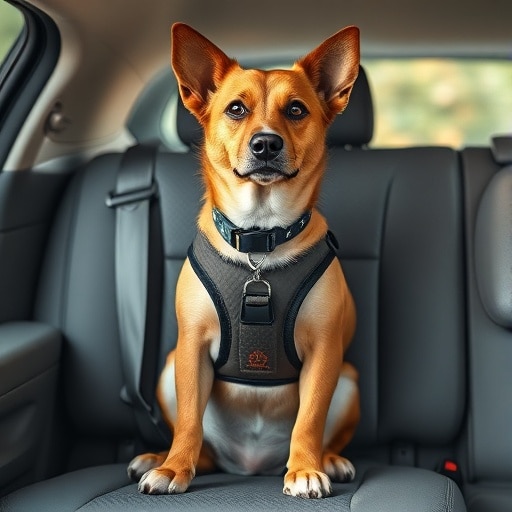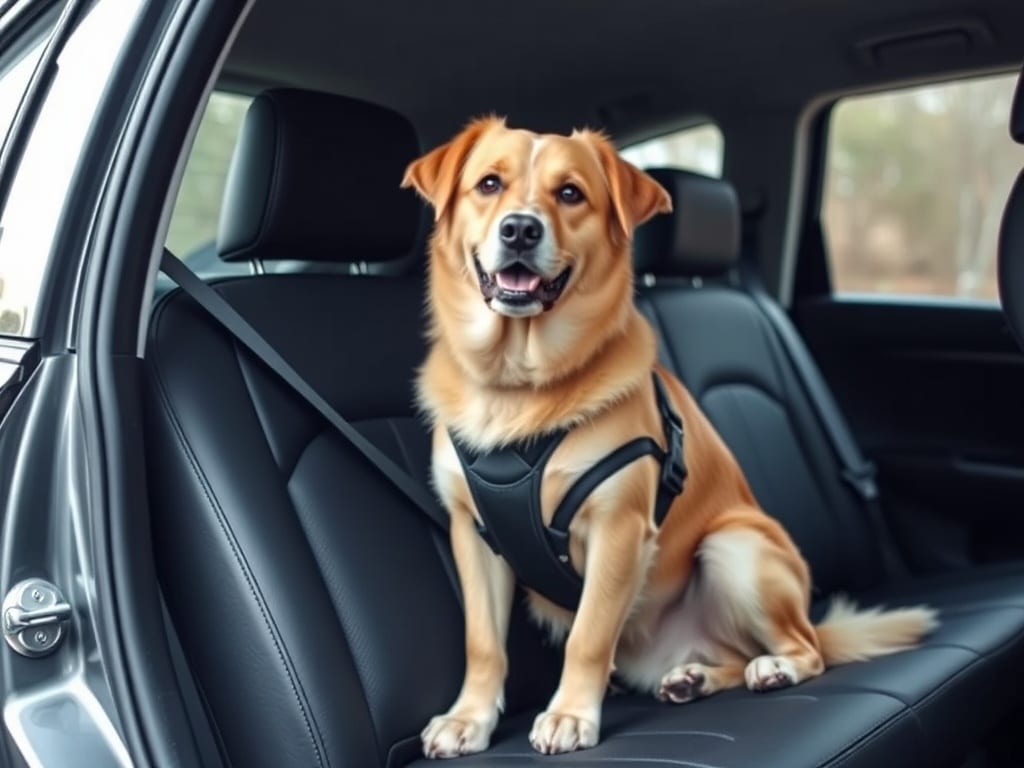Buckle Up, Pup! The Ultimate Guide to Dog Car Safety You NEED
Introduction to Dog Car Safety
Imagine the wind in your hair, your favorite tunes blasting on the radio, and your best friend happily panting in the passenger seat. Sounds like the perfect road trip, right? But are you sure your canine companion is as safe as they could be? Dog car safety is not just a nicety; it's a necessity. An unrestrained dog in a car can be a major distraction and, in the event of an accident, a significant hazard to both themselves and you. But how significant? Let’s unpack this critical topic.
Why is dog car safety important? Beyond the obvious, consider this: an unrestrained 50-pound dog in a 30 mph crash can become a 1500-pound projectile. Terrifying, isn’t it? That’s the force we're talking about. It’s about protecting their life and yours.
What are the risks of unrestrained dogs in cars? Distracted driving is a leading cause of accidents. An unrestrained dog can easily jump into the driver's lap, interfere with the pedals, or cause other dangerous situations. Additionally, in a crash, an unrestrained dog is at risk of severe injury or death, and could also injure human occupants.
Common myths about dogs in cars: Many believe that holding a dog in your lap is safe. This couldn't be further from the truth. In a collision, you won't be able to hold onto your dog, and you could both be seriously injured. Also, letting a dog stick its head out the window seems harmless, but it exposes them to debris, injury, and potential escape.
Legal Requirements for Dogs in Cars
Did you know that some areas have specific laws regarding dog car safety? It's not just about your pet's well-being; it might be the law. Ignoring these laws could lead to hefty fines. Regulations regarding animals in vehicles vary widely depending on your local and state jurisdictions.
Are there laws or regulations regarding dog car safety in my area? It's crucial to check your local and state laws. Some areas require dogs to be restrained in a carrier or with a seat belt harness, while others simply prohibit driving with an animal in your lap. A quick online search or a call to your local DMV can provide clarity.
What are the penalties for violating these laws? Penalties can range from warnings to substantial fines, depending on the severity of the violation and local regulations. In some cases, violations can even lead to points on your driving record.
How do these laws vary by location? Dog car safety laws are not uniform across the United States, and regulations can vary widely from state to state and even city to city. For example, some cities may ban driving with an animal in your lap, while states may mandate that dogs be properly restrained in a car. Always check local regulations before traveling with your pets.
The Safest Way for Dogs to Ride in Cars
Now, let's talk about the nitty-gritty: the various options for keeping your furry friend safe and secure. There are several options, each with pros and cons. Let's explore these options.
Options for dog car restraints:
- Crates: Offer maximum protection in a crash, as they fully enclose your dog.
- Harnesses: Secure your dog with a seat belt attachment, preventing them from moving around the car.
- Carriers: Suitable for smaller dogs, providing a safe and contained space.
- Seat Belts: Designed specifically for dogs, these are similar to human seat belts and attach to a harness.
Pros and cons of each restraint type: Crates can be bulky but offer the best protection. Harnesses are convenient but may not be as effective in high-speed crashes. Carriers are great for small dogs but can be restrictive. Seat belts are easy to use but may not be suitable for all dogs.
Understanding crash test ratings for dog car products: Look for products that have been crash-tested by reputable organizations like the Center for Pet Safety. These ratings provide valuable information about the product's performance in simulated car crashes.
Choosing the Right Dog Car Restraint
Selecting the right restraint is crucial. It's not a one-size-fits-all situation. Consider your dog’s size, breed, temperament, and even your car type.
Factors to consider when selecting a restraint:
- Dog Size and Breed: Small dogs are well-suited to travel in carriers, whereas larger breeds require a sturdier crate or harness.
- Temperament: Anxious dogs may benefit from a crate that provides a secure den-like environment. More relaxed dogs might do well with just a seat belt harness.
- Car Type: Some restraints are better suited for certain vehicles and may not work properly in others.
How to properly measure your dog for a harness or carrier: Measure your dog's chest girth, neck circumference, and length from neck to base of tail. Compare these measurements to the product's sizing chart to ensure a proper fit.
Where to buy reliable and safe dog car restraints: Reputable pet stores, online retailers, and veterinary offices are good places to start. Look for brands with positive reviews and crash test certifications.
Properly Installing and Using Dog Car Restraints
Buying the right restraint is only half the battle. Proper installation and usage are equally important.
Step-by-step Instructions for Installing Each Type of Restraint: Follow the manufacturer’s instructions carefully. Crates should be secured to the vehicle frame. Harnesses should be properly fitted and attached to the seat belt. Carriers should be placed on the floor or secured with a seat belt.
How to train your dog to accept and be comfortable in a car restraint: Start slowly. Introduce the restraint in a positive way with treats and praise. Gradually increase the time your dog spends in the restraint, and then introduce it in the car while stationary. Finally, take short trips before longer ones.
Common mistakes to avoid when using dog car restraints: Never use a leash attached directly to the car's seat belt, as this can cause serious injury in a crash. Ensure harnesses are snug but not too tight, and that the restraint is appropriate for your dog's size and weight.
Car Sickness in Dogs
Unfortunately, some dogs experience motion sickness. It's a common issue, but thankfully, there are ways to manage and prevent it.
Causes of Car Sickness: Car sickness is often caused by anxiety and stress, or the inner ear imbalances produced by motion. Puppies are particularly susceptible as their inner ear structures are not yet fully developed.
Symptoms: Common symptoms include excessive drooling, lip licking, panting, restlessness, vomiting and diarrhea.
Tips for Prevention:
- Withhold food 2-3 hours before travel.
- Ensure adequate ventilation by opening a window slightly
- Use calming pheromone sprays
- Consider motion sickness medication prescribed by your vet.
Consulting a Veterinarian: If car sickness is severe or persistent, consult your veterinarian. They can prescribe medication to help alleviate symptoms.
Preparing for a Road Trip with Your Dog
Road trips with dogs require extra planning. Packing essential items, planning rest stops, and keeping your dog entertained will make the journey enjoyable for everyone.
Essential Items to Pack:
- Food and water bowls
- Plenty of fresh water
- Dog food
- Leash and collar
- Waste bags
- Favorite toys
- Pet first aid kit
- Any necessary medications
- Comfortable bedding.
Planning Rest Stops: Schedule rest stops every two to three hours to allow your dog to relieve themselves, stretch their legs, and drink water. Always keep your dog on a leash during rest stops.
Entertainment and Comfort: Bring your dog's favorite toys, chews, or a blanket to help keep them relaxed and entertained during the drive.
Emergency Car Safety for Dogs
Being prepared for emergencies is an often overlooked aspect of pet travel safety but it is crucial to have an emergency plan for your furry friend.
What to do in case of an accident: Check on your dog first. If they are injured, keep them calm and seek veterinary attention immediately. If possible, move your car to a safe location and contact emergency services.
Creating an Emergency Plan: Keep a copy of your dog’s medical records in your car. Have a pet first aid kit readily accessible. Ensure your dog is microchipped and wearing identification tags with your contact information. A very useful thing to have would be an adjustable dog seatbelt such as this seatbelt that allows your dog to move but not too much that it can cause a risk.
Pet First Aid Basics: Learn basic pet first aid, including how to control bleeding, treat shock, and perform CPR on your dog.
Breed-Specific Considerations for Dog Car Safety
Different breeds have unique needs and challenges. Small breeds, large breeds, and brachycephalic breeds require tailored safety strategies.
Small Breeds: Small dogs can easily be injured in a car accident. Carriers and booster seats can provide added protection. Ensure it is a good fit.
Brachycephalic Breeds: (Pugs, Bulldogs, Boxers…) These breeds are prone to breathing difficulties, so ensure they have adequate ventilation and aren't overheated. Avoid stressful situations, which can exacerbate respiratory problems.
Large Breeds: Large dogs require sturdy restraints. Crates or heavy-duty harnesses are essential for their safety.
Dogs with Disabilities: Adapt your car safety strategies to accommodate dogs with disabilities or health conditions. Provide comfortable bedding, easy access to water, and any necessary medications. Consider their specific needs when choosing a restraint.
Other Car Safety Tips for Dogs
Beyond restraints, there are other essential tips to keep your dog safe and comfortable in the car.
Never Leave Your Dog Unattended: Temperatures inside a parked car can rise rapidly, even on a mild day. Never leave your dog unattended in a car, as this can lead to heatstroke or death.
"Unlock the Secrets to a Blissful, Healthier Puppy: Discover the Benefits of Holistic Housebreaking"
Protecting From Extreme Temperatures: Use window shades to block sunlight and keep the car cool. In winter, ensure your dog is warm enough with a blanket or sweater.
Preventing Jumping: Train your dog not to jump out of windows or doors. Use window guards or door barriers to prevent escapes.
Car Seat Covers: Car seat covers can help protect your car's interior from dirt, hair, and scratches. They also provide a comfortable surface for your dog to lie on.
Advanced Dog Car Safety Training
For anxious dogs, advanced training techniques can help them become more comfortable in the car.
Desensitization Exercises: Gradually expose your dog to the car in a positive way. Start by simply approaching the car, then sitting inside with the engine off, and eventually taking short drives around the block.
Positive Reinforcement: Use treats, praise, and toys to reward your dog for calm behavior in the car. Make car rides a positive experience.
Professional Dog Trainer: If your dog struggles with car anxiety, consider working with a professional dog trainer or behaviorist. They can provide personalized guidance and help you address any underlying issues.
Debunking Dog Car Safety Myths
Plenty of misconceptions circulate about dog car safety. Let’s set the record straight.
Riding in Laps: Holding a dog in your lap isn't safe, and this also inhibits the driver from safely operating the vehicle
Heads Out the Window: Dangerous due to flying debris.
Car Crash Safety Science: A 50 lb unrestrained dog turns into a 1500 lb projectile in a 30mph crash. This highlights the importance of restraints. As stated earlier, this can hurt humans and dogs.
Case Studies of Dog Car Accidents
In the interest of clarity, one story is worth more than one thousand statistics. Let’s examine some real-world examples to understand the consequences of neglecting dog car safety.
Real-Life Examples: Discuss real-life incidents where unrestrained dogs were injured or killed in car accidents. Highlighting the emotional and physical toll these incidents take on both pets and owners.
Lessons Learned: Emphasize how using proper restraints could have prevented injuries or fatalities in these accidents. Reinforce the importance of planning and preparation.
The Future of Dog Car Safety
Innovation never stops! The future of dog car safety promises many new advancements.
Innovations in Restraint Technology: Discuss emerging technologies in dog car restraint systems, such as advanced harness designs, improved crash-testing standards, and smart restraints that monitor your dog's vital signs during travel.
Emerging Trends: Explain how trends like pet-friendly autonomous vehicles and integrated pet safety features in cars are shaping the future of dog car travel.
Technology’s Role: Explore how technology such as GPS tracking, temperature monitoring, and remote camera systems can enhance the security of your pet.
Conclusion
Summarizing the importance of safe dog car travels: Dog car safety is paramount, and while it may add extra steps to your preparation, the benefits for both you and your best friend are undeniable. By understanding the risks, following legal requirements, choosing the right restraints, and implementing best practices, you can ensure a safe and enjoyable ride for everyone. Remember, your dog’s well-being is always worth the effort.
Encouragement: Prioritize your dog's well-being and take the necessary steps to protect them on the road. Safe travels!


